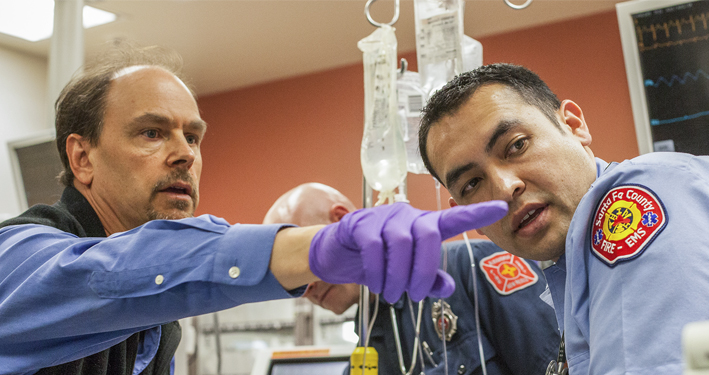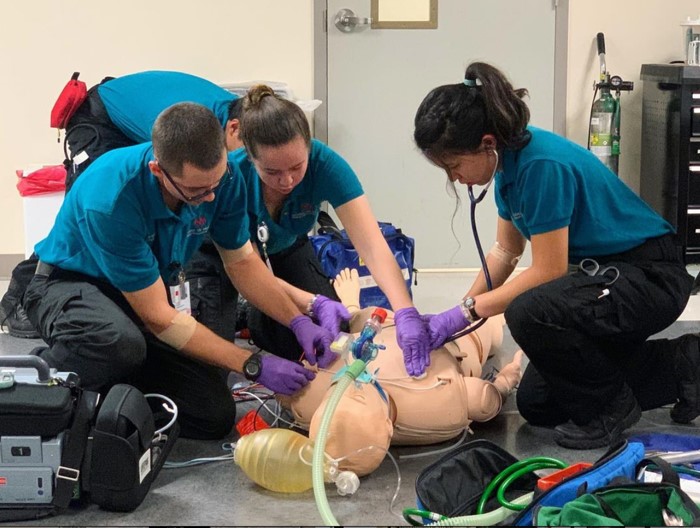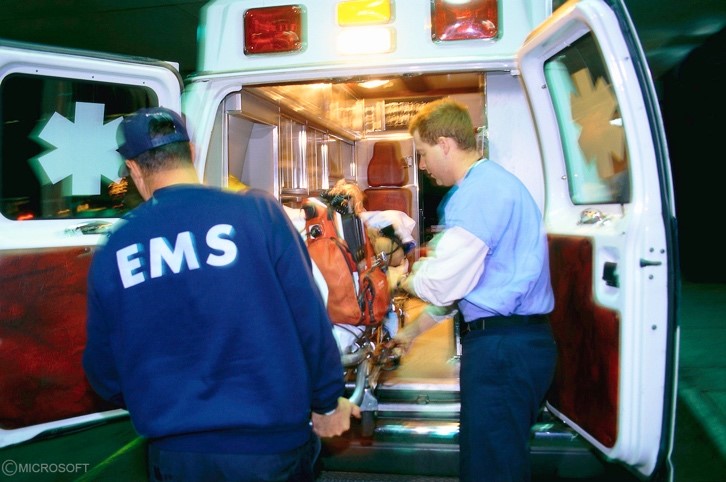
This course consists of 180-192+ hours of didactic instruction including both lecture and psychomotor skills instruction covering a range of foundational EMT Basic curriculum topics and EMT- basic level skills. Additionally, there is a clinical component where the learner will be required to assess a minimum of 10 patients in an approved clinical/field environment. Upon successful completion of the course, graduates will be eligible to sit for the National Registry EMT certification examination and obtain NM EMT-Basic certification.
The EMS Academy's EMT-Basic classes are held at the UNM EMS Academy in Albuquerque, UNM Branch Campuses, other partner colleges, and communities throughout the state of New Mexico.
Click tab that says “Course Search” that links to course search page
Students who currently hold a New Mexico EMT-Basic license are eligible for this program, which builds on the skills from the basic course and affords students clinical rotations as well as didactic and psychomotor lab work. This course consists of a minimum of 178 hours of didactic instruction including both lecture and psychomotor lab instruction on a broader range of skills, and at least 72 hours of clinical rotation with a local hospital ER or EMS service. Upon successful completion of the course, graduates will be eligible to sit for the National Registry Advanced EMT (AEMT) certification examination and obtain NM EMT-Intermediate certification.
The EMSA's EMT-Basic classes are held at the UNM EMS Academy, and at partner colleges, and communities throughout the state.
Course Search
The EMS Academy Paramedic training program began in 1974. The program today consists of approximately 1400 hours, including lecture, lab simulation, hospital clinicals, field experience, and capstone field internship. There are 2 separate course options, including either a certificate only or for college credit through the Bachelor of Science in EMS degree. Courses are completed in 10-12 months. Certificate courses are not offered every year, and may have unique enrollment criteria. After successful completion of either program, the student will have met all requirements set forth by the US Department of Transportation EMS Education Standards, New Mexico Scope of Practice for Emergency Medical Technician- Paramedic, the New Mexico Joint Organization on Education in Emergency Medical Services and the National Registry of EMTs.

The Paramedic Training Program provides advanced training beyond Emergency Medical Technician- Basic and Intermediate certification. Coursework focuses on critical thinking skills through in-depth patient assessment, advanced airway management, pharmacology, cardiac monitoring and treatment, and specialized care for trauma, pediatrics, and geriatric patients. Participants will learn numerous advanced skills that may include advanced airway management techniques, interpretation of EKGs, advanced cardiac, medical, and trauma life support protocols, as well as rescue operations, crisis scene management, and patient triage. Laboratory simulation training provides a safe and effective opportunity for students to develop psychomotor skills and apply concepts to clinical decision-making. Paramedic training includes lecture, laboratory simulation, hospital clinicals, field experience, and a capstone field internship. The program will prepare individuals to be competent entry-level Paramedics in the cognitive (knowledge), psychomotor (skills), and affective (behavior) learning domains.
Graduates of the course are awarded a certificate upon completion and are eligible to sit for the National Registry Paramedic certification exam, and additionally are eligible to apply for New Mexico EMS licensure.
Admission to Paramedic program courses through the EMS Academy are based on several factors, these may include but are not limited to the applicant’s performance on a pre-test, successful completion of all pre-requisite course work if applicable, and an interview. Service Sponsored, Satellite and Certificate non-credit courses may have additional eligibility requirements. A faculty admissions committee meets to select applicants through a competitive process. The Bachelor of Science Paramedic application process begins in December of each year and the applications are due in February of the following year for the upcoming fall program, please connect with the EMS Academy Academic Advisor for the specific deadline. Service Sponsored, Satellite and Certificate non-credit courses will have varying timelines for the application process which will be announced by the EMS Academy to the public and respective stakeholders.
Applicants to the Paramedic Program at the EMS Academy must hold a New Mexico EMT-Basic or EMT-Intermediate license. Applicants from out of state must complete the necessary out of state reciprocity to obtain New Mexico State licensure to be accepted into and ensure ability to matriculate into a paramedic course.
All Bachelors of Science in EMS paramedic program accepted students will also need to be accepted to UNM, declare EMS as their major, pay the normal tuition rate to UNM main campus for the courses, and enroll in the courses through UNM Main campus. Service Sponsored, Satellite and Certificate non-credit students
The UNM School of Medicine EMS Academy is accredited by the Commission on Accreditation of Allied Health Education Programs (www.caahep.org) upon the recommendation of the Committee on Accreditation of Educational Programs for the Emergency Medical Services Professions (CoAEMSP).
Commission on Accreditation of Allied Health Education Programs
Committee on Accreditation of Educational Programs for the Emergency Medical Services Professions
8301 Lakeview Parkway, Suite 111-312
Rowlett, TX 75088
214-703-8445
FAX (214) 703-8992
www.coaemsp.org
The EMS Academy recognizes that some individuals applying to our Paramedic programs may come with other medical licensure and/or experiences. However, for the continuity and consistency of programs the EMS Academy will not allow advanced placement of students into its Paramedic programs. More specifically, Physicians, Physician Assistants, Nurses, Nurse Practitioners, or other allied health professionals will not be granted advanced placement into a Paramedic program or be given credit for their current licensure or experiences. Anyone seeking admittance into a Paramedic program at the EMS Academy will apply through the standard application process and will adhere to all attendance and course policies.
Students currently enrolled in a Paramedic program who are removed for academic purposes will not be allowed to be placed into another EMS Academy Paramedic program that is currently in progress. Students removed for academic reasons can potentially start a new Paramedic class given the outcome of an EMS Academy Promotions and Evaluations Committee meeting or recommendation from an EMS Academy satellite program contractor (USAF of AFD).
Students removed from training due to non-academic reasons who are in good academic standing may be granted placement into another EMS Academy Paramedic class given the outcome of an EMS Academy Promotions and Evaluations Committee meeting or recommendation from an EMS Academy satellite program contractor (USAF of AFD).
In support of the EMS Academy’s mission, our policy is to give admission priority to New Mexico residents first and domestic non-New Mexico residents second. If space permits, up to one equally qualified international student may be admitted per year.
International applicants must demonstrate proficiency in English. If English is not your first language or if English is not the official language spoken in your country, you must submit results from the Test of English as a Foreign Language (TOEFL). The TOEFL is the only English language proficiency test accepted. Due to the highly technical nature of EMS training, the minimum acceptable score on the TOEFL is 587 on the paper-based test, 240 on the computer-based test, or 95 on the internet-based test. TOEFL scores are valid for two years from the test date. Scores more than two years old will not be accepted.

This four-year undergraduate program places emphasis on both the science and the humanity of prehospital medicine. The UNM EMS Academy is home to New Mexico’s only Bachelor of Science program in EMS and is one of only 13 programs offering a Bachelor’s degree in EMS in the U.S. Offered through the University of New Mexico School of Medicine, our program is one of a very few programs administered through an academic Department of Emergency Medicine. This provides our students exceptional opportunities to be mentored by Emergency Medicine faculty and residents and to participate in the day-to-day activities of a busy academic medical center.
The BS program may be started either as an incoming first-year student at UNM or as a student transferring with an associates degree or prior college courses.
Our curriculum was designed to teach and train paramedic leaders to be better prepared to handle the realities of a new era in prehospital medicine. By the time they leave EMSA, our graduates are excellent clinicians, teachers, researchers and leaders. They have the breadth of knowledge to think independently and to push the development of EMS. The program prepares students for advanced study; many of our graduates go on to obtain advanced degrees in education and science, medicine, physician assistant studies and business.
Prospective students should contact the EMS Academy Academic well in advance of their intended matriculation. See Academic Advisement section below.
Bachelor of Science in EMS Student Advising Sheet
Students in the EMS program (Pre-EMS and admitted students) are eligible for all UNM scholarships for which they qualify.
For more information, contact UNM SOM Financial Aid Office UNM SOM Financial Aid Office.
The EMSA offers two options to obtain college credit for licensed paramedics.
First, we offer a NRP to BS-EMS option, which gives students 47 EMS transfer credits towards UNM’s Bachelor of Science in Emergency Medical Services. This option is free and students must hold the NREMT's National EMS Certification at the Paramedic level.
The second license to credit option allows those who received their paramedic certification through UNM Emergency Medical Services Academy, the US Air Force Academy or the Albuquerque Fire Academy to convert the classes taken for certification into college credit hours in order to be able to apply them to a higher education degree. The fee to create the student record and post the courses with grades is $75 per course.
Please contact us to take advantage of the EMSA’s license to credit options at hsc-emsa@salud.unm.edu
As the lead EMS training agency for the state of New Mexico, EMSA is committed to providing prehospital education throughout the state. Since its inception in 1972, EMSA has taught courses in rural and frontier firehouses, EMS garages and schoolhouses, serving a population of 1.9 million people, across an area of over 121,000 square miles. We provide affordable EMS education and are currently the state's largest provider of prehospital education, with over 150 instructors throughout the state.

In an effort to provide accessible EMS training to rural areas, EMSA instructors travel across the state to teach First Responder, EMT basic and EMT intermediate courses. Didactic and training materials are delivered from the EMS Academy in Albuquerque using a dedicated fleet of trucks and trailers. We currently partner with multiple 2 year institutions across New Mexico to provide paramedic education.
New Mexico is rural, and the sixth most sparsely populated state in the US. Access to health care remains a serious issue. The Health Resources and Services Administration (HRSA), of the U.S. Department of Health and Human Services considers all of New Mexico’s counties, except Los Alamos, to be Health Professional Shortage Areas, meaning that there are shortages of all levels and specialties of health care providers throughout the state.
EMSA instructors teach First Responder, EMT basic and EMT intermediate courses around the state. Didactic and training materials are delivered from the EMS Academy in Albuquerque using a dedicated fleet of trucks and trailers.
EMSA also serves as a resource center for paramedic satellite programs across the state. We currently partner with three community colleges across New Mexico to provide paramedic education.
Here is a list of courses offered outside of Albuquerque.
EMS Academy
MSC 11 6260
1 University of New Mexico
Albuquerque, NM 87131
Phone: (505) 272-5757
Fax: (505) 272-6503
hsc-emsa@salud.unm.edu
Phone: (505) 272-5757
hsc-emsa@salud.unm.edu